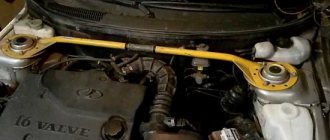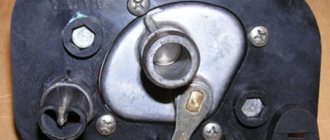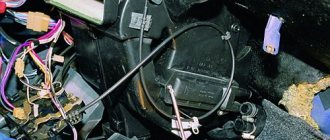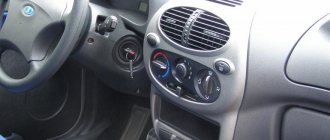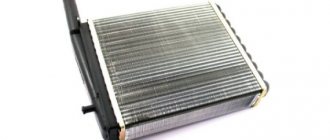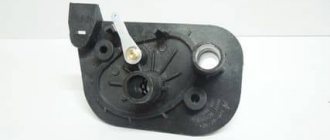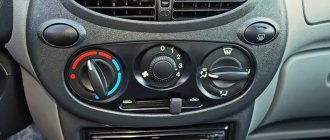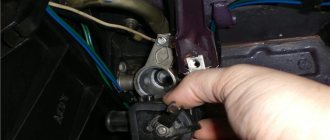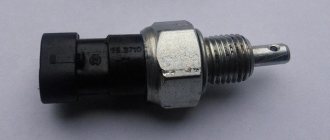You unlocked the car and started it to drive to work. It's cold outside, we turned on the heater and noticed that coolant began to flow into the cabin. The Lada Kalina stove faucet has fallen into disrepair again. The solution that localizes the problem is to move the tap under the hood. To do this you need:
- Lengthen the drive rod.
- Replace the pipes to the heater radiator.
It's easier to change in the future. If the tap starts leaking again, but not into the interior. So, where is the stove tap on Kalina? It is located under the dashboard at the center console level and is easy to find. Unfortunately, it cannot be repaired, the assembly can only be replaced. And this is the only reliable option related to replacement. We recommend installing the ceramic one instead of the factory version.
The ceramic element guarantees reliability, high wear resistance, and smooth operation. When installing the faucet, it is advisable to treat the installation site with rubber sealant. It is more convenient to do it on a pit or overpass. But, if such options are not available, then you can drive one wheel onto the curb.
Replacing the heater tap Lada Kalina
You unlocked the car and started it to drive to work. It's cold outside, we turned on the heater and noticed that coolant began to flow into the cabin. The Lada Kalina stove faucet has fallen into disrepair again. The solution that localizes the problem is to move the tap under the hood. To do this you need:
- Lengthen the drive rod.
- Replace the pipes to the heater radiator.
It's easier to change in the future. If the tap starts leaking again, but not into the interior. So, where is the stove tap on Kalina? It is located under the dashboard at the center console level and is easy to find. Unfortunately, it cannot be repaired, the assembly can only be replaced. And this is the only reliable option related to replacement. We recommend installing the ceramic one instead of the factory version.
The ceramic element guarantees reliability, high wear resistance, and smooth operation. When installing the faucet, it is advisable to treat the installation site with rubber sealant. It is more convenient to do it on a pit or overpass. But, if such options are not available, then you can drive one wheel onto the curb.
When is it necessary to replace the heater valve?
Repairing the heater valve on a Lada Kalina car is required in two cases:
- The faucet “sours” or “sticks.”
- The product leaks at the joints.
No matter what caused the problem, the product should be replaced. Otherwise, the consequences will be more serious. Signs of a faulty faucet:
- There is a smell of coolant in the cabin.
- We noticed traces of coolant on the floor of the car.
- The stove was turned on, but there was no heat.
A leaking heater faucet is considered not just another nuisance that will flood the interior, but a danger to the car’s ECU. If you notice traces of liquid under your feet, immediately carry out an inspection to find the possible cause of the leak. Use additional lighting or a flashlight to quickly inspect the heater valve. In addition to the faucet, the cause of antifreeze leakage may be damage to the pipes or radiator. You now know where the stove tap on Kalina is located. If you identify the source of the leak, which turns out to be a faucet, then you need to urgently replace it.
Summary
We hope that the article helped you find out where the stove tap on Kalina is located. And the main thing is that it is not so difficult to change it at home.
The best prices and conditions for the purchase of new cars
Credit 9.9% / Installments / Trade-in / 98% approval / Gifts in the salon
The heating system in the cabin of the budget Lada Kalina model can significantly increase comfort for the driver and his passengers. It ensures that the required temperature conditions are maintained inside the car. Along with such useful options as:
- "ABS";
- airbag;
- electric power steering;
- electric front windows;
- front seat heating function,
The design of the interior heater allows the manufacturer to achieve a fairly acceptable level of equipment, which is very worthy for a small-class Lada Kalina model and makes it competitive among its rivals in this segment.
Procedure for replacing the stove faucet.
Change the heater valve on a cold engine. Place a rag under your feet to absorb any spilled liquid. We will replace the stove valve without removing the dashboard. All we need is to get to the place where the heater valve is located on Kalina.
- Remove the air filter housing.
- Remove the ignition module.
- Unscrew the bolt and drain the antifreeze
- We unscrew the nut in the place where the stove pipes go into the cabin.
- Remove the upper heater pipe from the thermostat.
- Remove the lower pipe.
- Let's go to the salon.
- Disconnect the gas cable from the pedal.
- Remove the gas pedal along with the bracket.
- Unscrew the heater radiator cap.
- We bend the metal part, which is located to the left of the stove body.
- Partially unscrew one handbrake mounting bolt, and completely unscrew the other. Now you can unscrew the tunnel screws.
- Disconnect the cigarette lighter plug and the fuse box.
- We unscrew and disassemble the front console. Everything is visible and accessible, nothing is complicated.
- We remove the ashtray. In place of the emergency button there are two plugs. When you pull it out, you will see screws under them.
- Label and number all chips and wires. Then there will be no complications during assembly.
- Pull out the electronic control unit (ECU) as far as the wires will allow. Place it in a safe place, most importantly, away from the heater.
- Now you will have to unscrew all the bolts that you encounter during disassembly. Only then will it be possible to completely dismantle the front console.
- Remove the dashboard panel, move the radiator to the side, and then take out the air duct. You have reached the place where the Kalina stove tap is located.
Remove the old faucet, install the new one and reassemble everything in reverse order. We also recommend changing the pipes going to the radiator from the faucet.
Lada Oka frankenstein › Logbook › WARMTH IN A CAR (part 1) - getting rid of the heater tap, etc.
Hello Vsemushki)
Well, I’m writing again about the cigarette butt repairman) I already wrote earlier about the fact that the heater faucet is running in the car (this creates a lot of problems, such as the smell of antifreeze in the cabin, the constant addition of antifreeze, dirt in the lard, and less heat in the car! And one more thing Based on the experience with a penny, I decided that I would just remove the tap and install a copper pipe! Since during the entire time I was driving the cop, I almost never closed the tap, even in the summer! It’s all in the air, if you turn off the air supply, the heater radiator does not heat up the street air and does not warms the interior! This system is also used on our LADA KALINA. Where the faucet is not installed from the factory. Let's get to work) - first of all, I drained the antifreeze and removed the air intake casing from the engine compartment (held on by four screws) and saw a bunch of leaves, dirt and etc., but the worst thing was that there was a lot of rust hidden under the casing!
-Then I removed the tube and tap from the radiator and washed it under water with shampoo)))
Then I took and put the radiator back in place for fitting) I saw that the new pipe was almost touching the body of the car, and the engine compartment gasket did not match the pipes) Well, I took a round file and adjusted everything as it should)
Something like this) Put everything back in place! and I’m glad) now in the car the tap won’t run))) and I’ll adapt the remaining tap opening regulator somewhere else) But that’s not all! To be continued) thank you all and bye =)
What is the damper responsible for?
While the engine is running in the cooling system, the heated liquid moves through the heater radiator, while it heats the air flowing through it. The volume of air passing through the radiator and outside it is controlled by the main heater damper. Depending on how the temperature control knob is located on the dashboard, the amount of incoming air will depend.
You can distribute air movement throughout the cabin by turning the handle that regulates the position of the damper. But there are cases when the damper jams and it is impossible to properly regulate the flow of heat into the Kalina’s cabin.
If the problem is only with the valve, then you can correct the situation quite simply by tightening its cable. If after these actions the situation has not changed for the better, then you need to conduct a visual diagnosis of the condition of the mechanism and perform a number of simple steps.
Recommendations
Comments 36
The thermostat from which car costs from 2110 or from 2108?
It’s worth the tenth, but I don’t have time to post it in the BZ)
I put it on all my eyes, except Chinese and grants, I even put it on 21099, the effect is stunning
Well, I don’t know how with the oversized thermos) it didn’t work for me when I bought it) I immediately installed the tenth one and I like it!)
... “By the way, this place is rotting because water and snow entering through the air intake do not completely drain out, and splashing on the body ruins it))))” ... There should be a plastic casing that prevents water from getting there if it is installed CORRECTLY. And drainage from this casing occurs through a rubber valve. And if this valve, I would even say the valve, is clean from dirt and leaves, then there will never be rust there. Moreover, rotting.
Well, I won’t argue, of course) but I have this casing and it doesn’t fit tightly to the left side of the air duct (if you stand facing the soot), that is, water gets between the air duct and the small casing.
When reinstalling, the casing must be placed BEHIND the air duct
He stood there, I also stuck him in)
It seems like ceramic taps are on sale now, maybe it was worth trying? but the usual ones, yes, they constantly leaked. Most likely because we rarely use them, it sours, sticks and then breaks down and leaks.
I see the heater radiator is original, it should be warm if it’s not clogged with pieces of sealant.
Well, I put in a ceramic one for a penny, it seems to be normal, but I don’t use it at all) and on the perch I washed the radiator, it seems to be normal), but the bad thing is that aluminum has worse heat transfer than brass, so it heats worse in the okha than in the cop.
It’s normal and the aluminum heats up. When I had a new one, my eyes were already drying out. Then, as if I didn’t keep my own thermos, I started putting others in and that’s it, the warmth was no longer the same. I got fed up with this and stupidly went and bought a new stove radiator. Kraft, it was just the one that was in stock. When I took mine off, I also wanted to wash it, but pieces of sealant flew out of it. In general, I installed a new radiator and... there was still no heat, although I rebuilt the thermos on the 10th, my hand does not tolerate the hose that goes into the cabin, but there is no heat. and now, 4 years later, I recently changed it on 12k and let’s read the reviews, it turns out that you need to install the same DAAZ that is installed from the factory. It has the densest packing of heat sink plates and it’s like a labyrinth, it’s not visible to the light in short. Here it is it really blows boiling water, it hurts my hand, my nails curl up)
and I set the ceramic faucet to 2105. But it didn’t completely shut off the antifreeze. So I sold it.
I've never heard of such things as roditors! To be honest, when I bought the thermos, I didn’t open it at all, I just installed the tenth one and it’s also not possible to hold the tube, but it only heats so-so! Well, the faucet closed normally, I just helped it close with my second hand.
I myself flew by 700 rubles. I think I bought a new radiator, which means it will be hot. But that’s not the point. The radiator is not the same as the radiator. Just go to the store yourself, where there is a choice of 3-4 things, lay them out next to each other: Pramo, Luzar, Kraft, DAAZ and look at the honeycombs. Visually, in one there will be rare cracks, like in a fence). Of course, the air will fly through it and will not have time to heat up. Moreover, you look at the light and it can be seen. And in DAAZ it’s like small labyrinths, how the air winds through it. it's long, but understandable))
Well, I definitely won’t buy a new one just yet)
I've never heard of such things as roditors! To be honest, when I bought the thermos, I didn’t open it at all, I just installed the tenth one and it’s also not possible to hold the tube, but it only heats so-so! Well, the faucet closed normally, I just helped it close with my second hand.
Did you blow out the 10th thermos in the store? they are there too, 1 is normal, holds, and the other 3 let a large circle pass, because the design is somehow incomprehensible. The tin does not press tightly.
Assembly
We return the brake pedal to its place. The emphasis will prevent you from doing this. so it needs to be moved to the side and this will allow you to return the pedal to its rightful place. If the stop is bent forward, then after returning the pedal to its place, straighten the stop using pliers.
After connecting the pedal to the rod, do not forget to install the locking plate.
Also, do not forget to install, connect and be sure to configure the brake pedal pressure sensor:
Don't forget to connect and configure the brake pedal sensor. The brake lights should light up when you press the pedal lightly.
Also, we install the gas pedal bracket and the pedal itself on it. which we must fix on the bracket with a locking plate.
That's probably all in the cabin, now let's move on to the engine compartment. Don’t forget to put the steering rod back in place and screw the thermal protection back into place (if you unscrewed it):
We put the air filter in place. air duct then the platform for the battery and the battery itself.
So, everything is assembled, all that remains is to fill in the antifreeze and remove the air lock from the stove. Before pouring antifreeze, make sure that all hoses are put in place and all clamps are tightened, including the throttle body heating hose.
Frankly, after filling in the antifreeze and checking the cooling system, at first I was a little depressed that the stove was not heating again. In desperation, I added gas and noticed that at high speeds the air coming from the stove was much hotter. Then it dawned on me: there was an air lock in the system. Air accumulates at the highest point (I have it in the hoses) and does not allow antifreeze to circulate normally through the stove.
I expelled the air from the system in the same way as I have been doing for about 7 years. It is enough just to drive at high speeds (3-4 thousand rpm) and the flow of antifreeze will itself break the air plug into bubbles, and then carry them into the expansion tank. Monitor the antifreeze level and make sure that the expansion tank plug allows air inside well. and then you won’t be afraid of an airlock.
That's probably all, dear readers! I sincerely hope that this article will help you replace the stove radiator and you will no longer have problems with this unit. I wish that the stove in your car works perfectly, never leaks, and that even in severe frost, your car will be warm and cozy!
I installed the standard radiator using a reverse circuit on December 5, 2015. I’ve been driving with it for almost a month, the New Year is just around the corner, I’m very pleased with the stove so far))
Common faults
The stove itself on Kalina is well conceived, but due to the poor quality of the elements and parts, various troubles constantly happen to it. Even the latest models with climate control have various “diseases”.
The list of the most common faults looks like this:
- The heater core is leaking;
- the heater damper is jammed or does not open completely;
- failure of the fan or control unit;
- gear motor failure;
- the temperature sensor or heater resistor has become unusable;
- The cabin filter is clogged.
To find out where this or that element of the heating system is located, you should look at the operating instructions; there will definitely be a corresponding diagram there.
The design of the Kalina stove without climate control is such that the air sucked in by the fan passes through the air filter and enters the heater radiator. There it is heated and supplied to different areas of the cabin through adjustable grilles and openings. The dampers are controlled and the fan speeds are switched manually. This heating system is more reliable because it does not contain any electronics.
On a Lada Kalina with climate control, the rotation of the dampers is controlled by a gearmotor at the command of the electronic unit. The latter receives signals from a temperature sensor located inside the car and reacts accordingly to changes in the microclimate. The controller interacts with both the heater and air conditioner.
Let's sum it up
The heating system is simple. Timely diagnostics can save the owner of a LADA Kalina from unexpected breakdowns; the heater circuit will also help with this. Monitor the level of antifreeze, change it according to the regulations, and the system radiator will serve its regulated life, delighting you with warmth and comfort in the cabin.
The Lada Kalina air heater is considered one of the best in terms of heat performance in the VAZ family, but is far from the most reliable in operation. Problems begin almost at the car dealership, as many motorists say. But most of the problems are completely solvable, and often even without the involvement of car service specialists.
Diagnosis and troubleshooting
The easiest way to resolve the issue is regarding the cabin filter. For the first time, thorough blowing of the element will be enough, but then it is better to replace it. The real problem is a leaking radiator or a broken fan; an expensive replacement of the unit cannot be avoided. An equally high price will have to be paid for a new control unit.
It will be somewhat cheaper to install a new temperature sensor, gearmotor or resistor for the Kalina heater. Moreover, the malfunction still needs to be correctly diagnosed, which can be quite difficult. A burnt resistor is easily identified - the fan only runs at maximum speed.
It is more difficult to check the sensor hidden in the lighting shade. Symptom of a malfunction - a hot or cold stream flows from one or more grilles, regardless of the position of the regulator handle.
It is more difficult to detect how well the mechanical heater regulator is functioning. To do this, you need to get to it by disassembling part of the front panel. In the same way, the proper operation of the air dampers is determined.
To carry out diagnostics, it is better to start searching for problems with the most accessible elements, and only then start disassembling.
Heating system composition
The operating principle of the heater in the Lada Kalina is very simple. It is built on a supply and exhaust circuit. The heater circuit contains:
- cabin air filter;
- air ducts;
- heater radiator;
- electric fan;
- air flow and fan operating mode control module.
The design of the interior stove looks exactly like this, and is located behind the dashboard and only the system controls are present on its front surface in the Lada Kalina cabin. A running engine generates heat, which is removed from it by the cooling system. This circuit includes a heating radiator. The circulating liquid heats the honeycombs, from which the warm flow is directed into the cabin by means of a fan. Adjustment of the required temperature, strength and direction of the air stream is carried out using the handles and dampers present in the cabin. Sometimes the dampers need to be adjusted.
How to change a radiator
The operation is very labor-intensive, for which the car service center will charge you a hefty sum. But there is another, slightly barbaric, but fast and widely practiced method. The work flow diagram is as follows:
- Drain the antifreeze, disconnect and remove the battery, and then disconnect the hoses from the heater pipes.
- Unscrew the nut located near the fittings in the engine compartment. It holds a steel plate that will interfere with the removal of the heater.
- Remove the gas pedal and pull out the steel brake pedal shaft. Unscrew the decorative panel and behind it the plastic panel covering the stove radiator.
- To remove it, cut an opening in the plastic frame that allows you to pull the radiator towards the driver.
- Install the new element and reassemble in the reverse order. The cut opening can be sealed with plastic and decorated in any suitable way.
When performing the operation, it is worth moving the controller located directly under the stove to another place. Antifreeze dripping from it can damage sensitive electronics. Also, with the radiator removed, it is easy to change a faulty heater valve or gear motor, because access to them will be open. The gearbox is a single unit with a damper position sensor and can also be changed entirely.
Fan replacement
The most convenient way to get to the unit is from the passenger seat, which will have to be dismantled so that you don’t have to do acrobatics inside the cabin. The chair runners are held in place by 4 13 mm nuts; unscrewing them is not difficult. Further work on replacing the fan is carried out in the following sequence:
- Remove the cabin filter and remove dirt and dust from the opening.
- Unscrew 4 screws located on the back wall of the glove compartment, and another one under the right heater grille.
- Remove the plastic cover from the stand and unscrew the 2 screws that secure the panel and the blower unit.
- Remove the blower unit, lift the plastic panel and loosen the 2 fan mounting nuts underneath it.
- Move the dashboard as far back as possible and secure it. The turbine must be removed from below, from a lying position.
You should not rush to change the fan when it only works at speed 1 and the heater switch is at maximum. This is a sure sign that the resistor located below the glove compartment has failed. The part is a small green plastic panel with a connection connector. Replacing the heater resistor is carried out without any disassembly; you just need to disconnect the connector and unscrew the 2 screws that secure it to the body.
Basically, troubleshooting the Kalina stove is not a difficult job, but very labor-intensive. To change a small part, you need to spend time disassembling to get to it.
